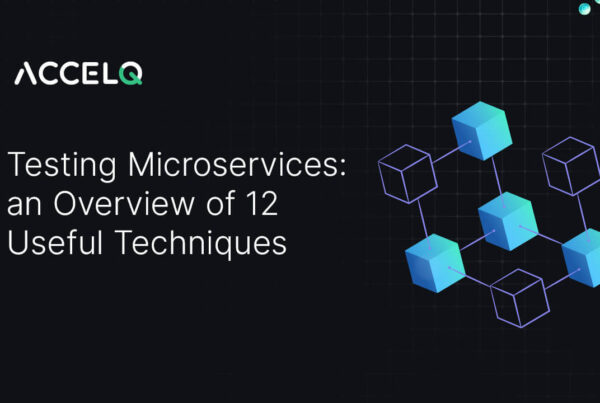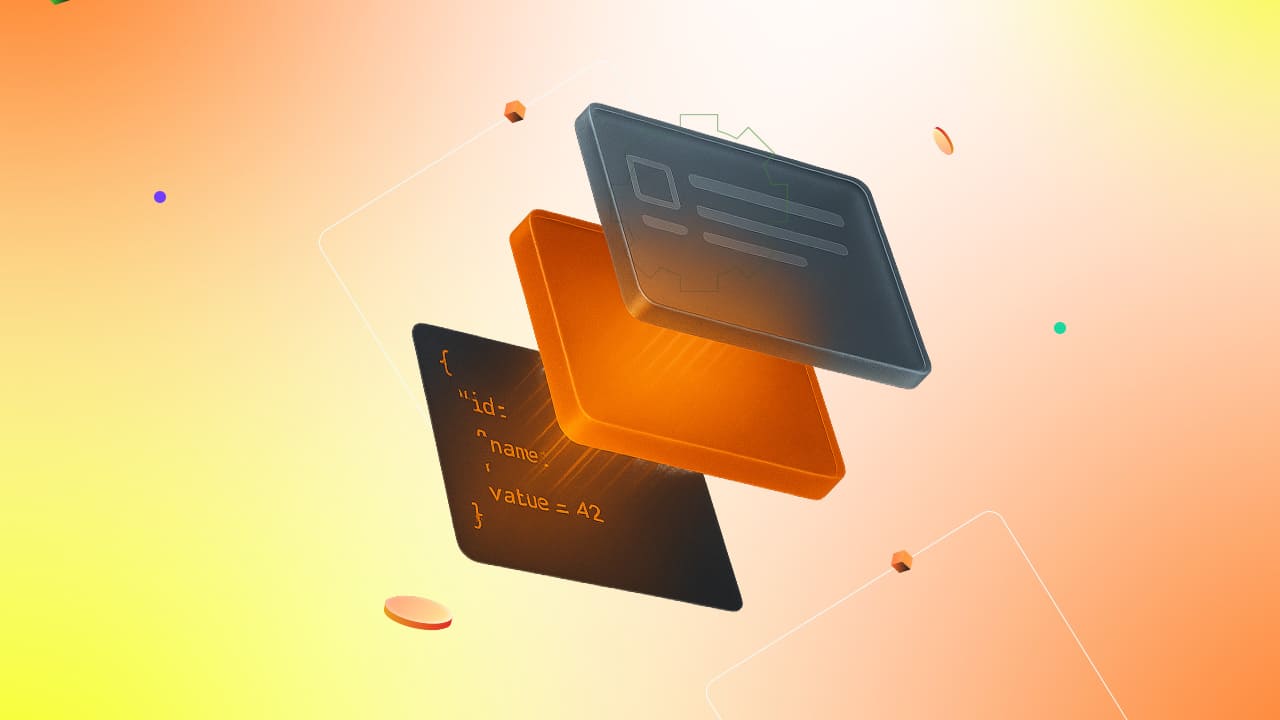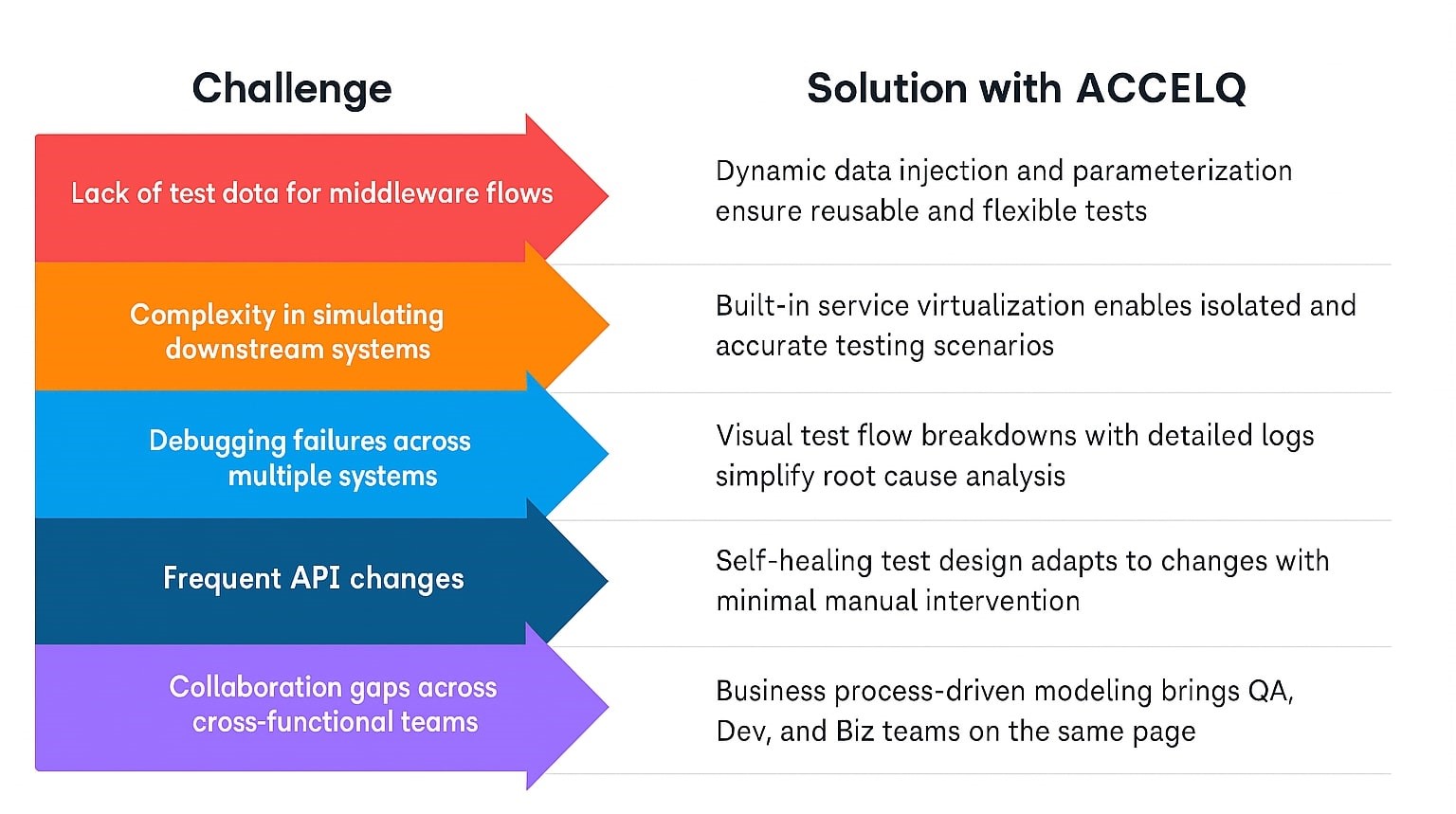Unlocking Middleware Testing: What You Need to Know

In today’s connected digital landscape, applications rarely function in isolation. Whether a banking app connects to a backend server or an e-commerce site interacting with a payment gateway, middleware is essential to keep these systems working together. Therefore, middleware testing is necessary to guarantee efficient communication, data integrity, and performance between the integrated systems.
This blog will discuss middleware testing, why it is important, and how contemporary automation platforms such as ACCELQ make this aspect of quality engineering significantly easier.
- Understanding Middleware: The Invisible Connector
- What is Middleware Testing?
- Key Middleware Testing Scenarios
- Why is it so Important?
- Manual vs. Automated Middleware Testing
- ACCELQ for Middleware Testing
- Middleware Testing Challenges
- Best Practices for Middleware Testing
- The Future of Middleware Testing: What’s Next?
- Conclusion
Understanding Middleware: The Invisible Connector
Middleware refers to software that connects different applications, services, or systems, facilitating data exchange and communication. It can include:
- Message brokers like Apache Kafka or RabbitMQ
- Integration platforms like MuleSoft or Dell Boomi
- Enterprise service buses (ESBs) such as TIBCO or IBM WebSphere
- APIs and microservices function as mediators between frontend and backend systems
The point is that middleware deals with authentication, logging, data transformation, and message queuing; it ensures that your user-facing applications work properly with the underlying infrastructure.
What is Middleware Testing?
The middleware testing process ensures all components interacting through middleware work correctly and reliably. Instead of directly testing a user interface or a database, middleware testing focuses on validating:
- Data transmission between systems
- Communication protocols (e.g., SOAP, REST, JMS)
- Business logic embedded in the middleware layer
- Error handling and data transformation
- Message queuing and processing behavior
That’s something every enterprise system with a dependency on a multi-tier architecture (especially in banking, telecom, health care, and retail, where integrations tend to be deep and mission-critical) cannot do without.
Key Middleware Testing Scenarios
Here are some common testing scenarios for testing middleware:
- API Interaction Validation: Ensuring that APIs used by middleware return the correct data formats and statuses.
- Message Queue Testing: Validating that messages are queued, consumed, and processed in order without loss.
- Data Transformation Testing: Checking that input data gets accurately transformed to the expected output format.
- Security Testing: Ensuring that middleware components enforce authentication, authorization, and encryption.
- Error & Exception Handling: Testing connection failures and malformed input data to test for error recovery and reporting.
- Performance Testing: Testing the middleware while under load to determine latency or bottlenecking.
To explore how automated middleware testing fits into modern enterprise testing strategies, check out our detailed guide on API testing.
Why is it so Important?
Inadequate testing at the middleware layer can lead to serious problems:
- Integration failures that break business workflows
- Data inconsistency between connected systems
- Security vulnerabilities due to poor encryption or access control
- Unscalable services under peak user load
- Undetected transformation errors leading to business rule failures
These issues often go unnoticed in UI testing but surface in production, causing reputational and financial damage. This is why middleware testing must be part of any robust enterprise test automation strategy.
Manual vs. Automated Middleware Testing
Manual testing for middleware is error-prone and time-consuming, especially when verifying complex message flows or large data payloads. Automated middleware testing offers:
- Speed and repeatability across different environments
- Comprehensive validations of message contents, headers, and flows
- CI/CD integration for continuous testing pipelines
- Early defect detection before frontend issues arise
For some test types, to reach this level of coverage is only possible with a test automation platform that is able to handle different middleware technologies, i.e, REST/SOAP APIs, JMS, MQs, and can transit across application tiers in an agnostic manner.
Learn more about why automated software testing is a game-changer.
ACCELQ for Middleware Testing
ACCELQ’s AI-powered, codeless test automation platform is uniquely equipped to handle middleware testing with the following features:
Unified Automation Across Layers
ACCELQ allows users to test web, API, backend, middleware layers, and approval workflows with a single test flow to ensure end-to-end validation of the business process.
Native API and Message Queue Support
Features such as built-in support for REST, SOAP, JSON, and message queues such as RabbitMQ and Kafka enable ACCELQ to cast and verify complex middleware transactions.
Visual Test Modeling
Test scenarios are designed using intuitive visual flows, making it easier for non-programmers to collaborate on middleware testing.
CI/CD Pipeline Integration
Integrate middleware validations within your CI/CD pipeline to catch integration issues early.
Intelligent Change Impact Analysis
ACCELQ detects middleware changes and auto-adjusts test flows, ensuring continuous alignment with evolving services.
Explore our platform’s full capabilities on the ACCELQ Live for Enterprise Apps page.
Middleware Testing Challenges (and How to Solve Them)
Middleware Testing is a tricky business, even for mature teams. With flaky test data, regular API churn, and delicate system integration, reliable end-to-end validation is no small challenge. ACCELQ’s intelligent automation makes it easy – Dynamic data handling, Service Virtualization, visual debugging, and self-healing tests maintain your middleware workflows healthy and release-ready.
These pain points highlight the need for a modern testing approach that’s adaptable, scalable, and built for integration-heavy ecosystems.
Best Practices for Middleware Testing
To ensure comprehensive and effective middleware testing, follow these best practices:
- Start testing early: Validate integration points during the development phase.
- Test for edge cases: Include invalid payloads, null values, and timeouts.
- Automate regression: Ensure backward compatibility with every middleware change.
- Monitor real-time traffic: Use logs and monitoring tools to validate runtime behavior.
- Collaborate across teams: Encourage joint ownership between QA, DevOps, and API teams.
The Future of Middleware Testing: What’s Next?
As enterprises continue to shift toward microservices, hybrid cloud, and event-driven architectures, middleware will only grow more complex. Traditional testing approaches—limited to front-end validations or unit tests—won’t be enough. The future demands autonomous, intent-driven testing that understands business logic and adapts dynamically.
AI and machine learning will also play a larger role, enabling predictive test coverage, smart data generation, and real-time failure diagnostics. Platforms like ACCELQ are already leading this shift with features like self-healing automation, auto-discovery of middleware endpoints, and behavior-driven testing models.
Conclusion
Middleware testing might not be flashy, but it’s the bedrock of enterprise application reliability. By validating the “in-between” layers, companies can stop cascading failures, increase data credibility, and speed digital transformation.
With solutions like ACCELQ, teams can automate middleware testing with no code, decreasing risk and increasing overall test coverage.
If your business relies on complex integrations, don’t ignore the middleware. Embrace a modern, AI-powered approach to automated test coverage and build confidence in every system interaction.
Ready to streamline your middleware testing efforts?
Start your free trial today and see how ACCELQ makes end-to-end automation simple, even across the most complex enterprise ecosystems.
Balbodh Jha
Associate Director Product Engineering
Balbodh is a passionate enthusiast of Test Automation, constantly seeking opportunities to tackle real-world challenges in this field. He possesses an insatiable curiosity for engaging in discussions on testing-related topics and crafting solutions to address them. He has a wealth of experience in establishing Test Centers of Excellence (TCoE) for a diverse range of clients he has collaborated with.
You Might Also Like:
 The Ultimate 2025 Guide to Blockchain in Software Testing
The Ultimate 2025 Guide to Blockchain in Software Testing
The Ultimate 2025 Guide to Blockchain in Software Testing
 Testing Microservices – The Top Useful Techniques
Testing Microservices – The Top Useful Techniques
Testing Microservices – The Top Useful Techniques
 Is Your App Ready for the European Accessibility Act?
Is Your App Ready for the European Accessibility Act?


































